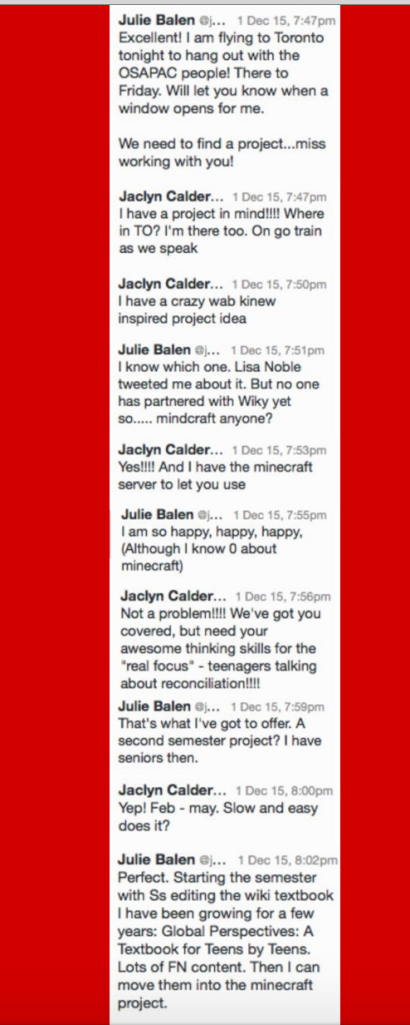
How is your #oneword guiding your work and learning this year?
DISCIPLINE
Six months ago I had defined my #oneword as the ability,
to say “no” to those opportunities that fall outside of one’s focus. (Collins, 2001)
This definition isn’t wrong, but it is simplistic.
Jim Collins, author of Good to Great describes both disciplines of thought and of action.
To have discipline of thought is to
- Confront the brutal facts (yet never lose faith), and
- Define what the one big thing is that is important to me (who am I; what I am about or my Hedgehog Concept) and transcend the curse of competence.
To have disciplined action is to
- Exercise self-discipline; to know that I have more than a job to do; I have a responsibility;
- Use technology as an accelerator for great performance; to be intentional in its use.
I have spent the past six months thinking deeply about these constraints. What am I best at? What drives the educational engine of my classroom? What is the driving force of my educational passion? I talked to many people inside and outside of education. I considered my ‘from the gut’ reactions to decisions made by parents, students, colleagues, and administrators. I examined what I did say ‘yes’ to and why. Did my thinking and my action align?
I have taught at a First Nations school for the past 16 years. I have always worked at helping my students develop their communication skills not just because that was my job, but because I believed that if my students’ were confident in speaking, reading, writing, and creating then there was a better chance that they would find a way to tell their story. I have done a myriad of things over the years inside and outside the classroom:
- Stratford trips
- Student Council advisor
- Art events
- Leadership courses
- School newspaper
And likely some of these activities supported some of the students in their lives after high school. Yet, when I returned to teaching after a three year stint as a central coach, I was determined to ensure that the students had hard skills in using the technologies available to them. This commitment on my part precluded the organization or participation in those other more customary high school activities (most of which are extra-curricular) because I had to do the learning too!
The other thing that happened post-2013 was (and is) the growing movement of First Nations people who have entered the pubic arena to speak to the inequities that their people have faced both historically and continue to in the present day. Sparked by the Idle No More Movement, my students became more interested in all aspects of their culture and history. There has been explicit interest in that learning, and from my perspective, there are more students willing to share their understanding of the world (ways of knowing) with me.
This is crucial contextual information because while all the above is true, I was having this “what is my focus” debate with myself. Maybe it is obvious to others, but besides learning how to use technology as an accelerator for learning and teaching, I was also facilitating collaborative inquiries (CI), writing on e-learning teams, and working with OSAPAC. This diverse array of educational experiences did not feel like ‘discipline’ to me.
I had this conversation at the same time as I was reading Good to Great:

The #craftreconciliation project has clarified the disciplined thought and action that has emerged in my classroom.
- My students and I had learned how to integrate technology into the teaching – learning process and the technology was now an accelerator in the learning process.
- #Craftreconciliation offered the opportunity for increasingly rich conversation about technology, inquiry, and pedagogy. BUT, it also created a platform from which I could support First Nations students in discovering their voices and inserting them into the conversation.
This then is ‘discipline’ six months later:
What am I best at?
I have the skill, the perseverance, the perspective to support my students.
What drives the educational engine of my classroom?
A blend of high expectations, critical and independent thinking, and flexible support for the process of learning.
What is the driving force of my educational passion?
An unwavering belief that First Nations students are the next generation of leaders in this country.
So, what’s your reflection on your #oneword for 2016?
Please share your thinking with me and others by leaving a comment below.

Pingback: Ontario Educator Blogs: Checking on on #OneWordONT | OSSEMOOC
It is so great that you have the answers (or at least, the current answers!) to your three circles. I love the driving force of your passion! As I work my way through Good to Great, I find myself reflecting on how my experiences to date and how my current understanding of “where I am” will end up influencing my own Hedgehog Concept. Thank you for sharing!
LikeLike
Thanks for stopping by Heather.
It took me fully six months post-reading to be able to identify and then articulate my hedgehog. It was the long drive to Cornwall and back that got me there!!
LikeLike
“What am I best at? What drives the educational engine of my classroom? What is the driving force of my educational passion?” & “Did my thinking and my action align?” What great guiding questions! I have not read “Good to Great,” but your post has given me pause. Thanks!
LikeLike